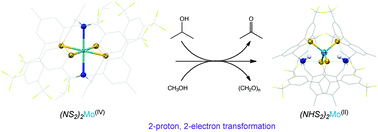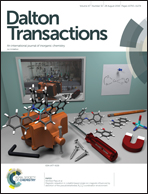Easily reduced bis-pincer (NS2)2molybdenum(iv) to (NHS2)2Mo(ii) by alcohols vs. redox-inert (NS2)(NHS2)iron(iii) complexes†
Abstract
Iron and molybdenum complexes supported by a pincer-type dianionic [NS2]2− donor were prepared to compare their structural, spectroscopic, and electrochemical properties. The versatility of the [NS2]2Mo(IV) complex (2) to access different oxidation states was evidenced in the activation of methanol and isopropanol, oxidising them to formaldehyde or acetone with concomitant reduction and protonation to afford [NHS2]2Mo(II), complex (3). This redox behaviour contrasts with the null reactivity observed for the analogous ferric complex [NS2][NHS2]Fe(III) (1). Complex 2 presents a quasi-reversible process at E1/2 = −0.80 V relative to the ferrocenium/ferrocene couple (Fc+/Fc), which is attributed to the Mo(IV)/Mo(V) redox couple. Two irreversible cathodic processes were observed at Ecp = −1.59 and −2.20 V, which are attributed to the Mo(IV)/Mo(III) and Mo(III)/Mo(II) redox couples. Cyclic voltammetry and solid-state structures obtained by X-ray crystallography support a 2H+ and 2e− process, whereby the Mo(IV) centre in 2 is reduced sequentially to Mo(III), and finally to Mo(II) in 3. These redox events were observed at Ecp = −1.22 and −2.15 V (vs. Fc+/Fc) in the anodic cyclic voltammograms of 2 in THF in the presence of acid. A new reduction peak was detected under these conditions at Ecp = −2.30 V, consistent with electrocatalytic proton reduction. This was corroborated for 2 as a catalyst precursor in the presence of increasing amounts of p-toluenesulfonic acid, with the addition of 2 to 14 equivs resulting in an increase of the current measured.

- This article is part of the themed collection: In celebration of Richard Andersen’s 75th birthday


 Please wait while we load your content...
Please wait while we load your content...